Identification of microRNA Signatures in Peripheral Blood of Young Women as Potential Biomarkers for Metal Allergy
Abstract
1. Introduction
2. Materials and Methods
2.1. Study Participants and Patch Test
2.2. Patch Test Procedure
2.3. Blood Samples and RNA Extraction
2.4. Microarray Analysis
2.5. Processing Microarray Data
2.6. Real-Time Quantitative Polymerase Chain Reaction
2.7. Statistical Analysis
3. Results
3.1. Results of Patch Test
3.2. Microarray Analysis
3.3. Pathway Analysis
3.4. Real-Time qPCR Results
4. Discussion
5. Conclusions
Author Contributions
Funding
Institutional Review Board Statement
Informed Consent Statement
Data Availability Statement
Acknowledgments
Conflicts of Interest
References
- Saito, M.; Arakaki, R.; Yamada, A.; Tsunematsu, T.; Kudo, Y.; Ishimaru, N. Molecular Mechanisms of Nickel Allergy. Int. J. Mol. Sci. 2016, 17, 202. [Google Scholar] [CrossRef] [PubMed]
- Nassau, S.; Fonacier, L. Allergic Contact Dermatitis. Med. Clin. N. Am. 2020, 104, 61–76. [Google Scholar] [CrossRef]
- Budinger, L.; Hertl, M. Immunologic mechanisms in hypersensitivity reactions to metal ions: An overview. Allergy 2000, 55, 108–115. [Google Scholar] [CrossRef] [PubMed]
- Peltonen, L. Nickel sensitivity in the general population. Contact Dermat. 1979, 5, 27–32. [Google Scholar] [CrossRef] [PubMed]
- Kitagawa, M.; Murakami, S.; Akashi, Y.; Oka, H.; Shintani, T.; Ogawa, I.; Inoue, T.; Kurihara, H. Current status of dental metal allergy in Japan. J. Prosthodont. Res. 2019, 63, 309–312. [Google Scholar] [CrossRef]
- Hosoki, M.; Bando, E.; Asaoka, K.; Takeuchi, H.; Nishigawa, K. Assessment of allergic hypersensitivity to dental materials. Biomed. Mater. Eng. 2009, 19, 53–61. [Google Scholar] [CrossRef]
- Yoshihisa, Y.; Shimizu, T. Metal allergy and systemic contact dermatitis: An overview. Dermatol. Res. Pract. 2012, 2012, 749561. [Google Scholar] [CrossRef]
- Yokozeki, H.; Katayama, I.; Nishioka, K.; Kinoshita, M.; Nishiyama, S. The role of metal allergy and local hyperhidrosis in the pathogenesis of pompholyx. J. Dermatol. 1992, 19, 964–967. [Google Scholar] [CrossRef]
- Bruze, M.; Isaksson, M.; Edman, B.; Bjorkner, B.; Fregert, S.; Moller, H. A study on expert reading of patch test reactions: Inter-individual accordance. Contact Dermat. 1995, 32, 331–337. [Google Scholar] [CrossRef]
- Lachapelle, J.M.; Maibach, H.I. Patch Testing and Prick Testing: A Practical Guide Official Publication of the ICDRG Berlin; Springer: Berlin/Heidelberg, Germany, 2009. [Google Scholar]
- Cutler, C.P. Use of metals in our society. In Metal Allergy: From Dermatitis to Implant and Device Failure, 1st ed.; Chen, J.K., Thyssen, J.P., Eds.; Springer: Cham, Switzerland, 2018; pp. 3–16. [Google Scholar]
- Minang, J.T.; Arestrom, I.; Troye-Blomberg, M.; Lundeberg, L.; Ahlborg, N. Nickel, cobalt, chromium, palladium and gold induce a mixed Th1- and Th2-type cytokine response in vitro in subjects with contact allergy to the respective metals. Clin. Exp. Immunol. 2006, 146, 417–426. [Google Scholar] [CrossRef]
- Wisgrill, L.; Werner, P.; Jalonen, E.; Berger, A.; Lauerma, A.; Alenius, H.; Fyhrquist, N. Integrative transcriptome analysis deciphers mechanisms of nickel contact dermatitis. Allergy 2021, 76, 804–815. [Google Scholar] [CrossRef] [PubMed]
- Hashizume, H.; Seo, N.; Ito, T.; Takigawa, M.; Yagi, H. Promiscuous Interaction between Gold-Specific T Cells and APCs in Gold Allergy. J. Immunol. 2008, 181, 8096–8102. [Google Scholar] [CrossRef] [PubMed]
- Vos, G.; Abotaga, S.; Liao, Z.; Jerschow, E.; Rosenstreich, D. Selective effect of mercury on Th2-type cytokine production in humans. Immunopharmacol. Immunotoxicol. 2007, 29, 537–548. [Google Scholar] [CrossRef] [PubMed]
- Kawano, M.; Nakayama, M.; Aoshima, Y.; Nakamura, K.; Ono, M.; Nishiya, T.; Nakamura, S.; Takeda, Y.; Dobashi, A.; Takahashi, A.; et al. NKG2D+ IFN-γ+ CD8+ T cells are responsible for palladium allergy. PLoS ONE 2014, 9, e86810. [Google Scholar] [CrossRef] [PubMed]
- Martin, S.F. New concepts in cutaneous allergy. Contact Dermat. 2015, 72, 2–10. [Google Scholar] [CrossRef]
- Kaplan, D.H.; Igyarto, B.Z.; Gaspari, A.A. Early events in the induction of allergic contact dermatitis. Nat. Rev. Immunol. 2012, 12, 114–124. [Google Scholar] [CrossRef] [PubMed]
- Friedman, R.C.; Farh, K.K.; Burge, C.B.; Bartel, D.P. Most mammalian mRNAs are conserved targets of microRNAs. Genome Res. 2009, 19, 92–105. [Google Scholar] [CrossRef]
- Løvendorf, M.B.; Skov, L. MicroRNAs in Skin Diseases, 1st ed.; Academic Press: Cambridge, MA, USA, 2015; pp. 177–205. [Google Scholar]
- Iorio, M.V.; Croce, C.M. MicroRNA dysregulation in cancer: Diagnostics, monitoring and therapeutics. A comprehensive review. EMBO Mol. Med. 2012, 4, 143–159. [Google Scholar] [CrossRef]
- Sonkoly, E.; Wei, T.; Janson, P.C.; Saaf, A.; Lundeberg, L.; Tengvall-Linder, M.; Norstedt, G.; Alenius, H.; Homey, B.; Scheynius, A.; et al. MicroRNAs: Novel regulators involved in the pathogenesis of psoriasis? PLoS ONE 2007, 2, e610. [Google Scholar] [CrossRef]
- Yu, X.; Wang, M.; Li, L.; Zhang, L.; Chan, M.T.V.; Wu, W.K.K. MicroRNAs in atopic dermatitis: A systematic review. J. Cell. Mol. Med. 2020, 24, 5966–5972. [Google Scholar] [CrossRef]
- Weidner, J.; Bartel, S.; Kilic, A.; Zissler, U.M.; Renz, H.; Schwarze, J.; Schmidt-Weber, C.B.; Maes, T.; Rebane, A.; Krauss-Etschmann, S.; et al. Spotlight on microRNAs in allergy and asthma. Allergy 2021, 76, 1661–1678. [Google Scholar] [CrossRef] [PubMed]
- Specjalski, K.; Jassem, E. MicroRNAs: Potential Biomarkers and Targets of Therapy in Allergic Diseases? Arch. Immunol. Ther. Exp. 2019, 67, 213–223. [Google Scholar] [CrossRef] [PubMed]
- Vennegaard, M.T.; Bonefeld, C.M.; Hagedorn, P.H.; Bangsgaard, N.; Lovendorf, M.B.; Odum, N.; Woetmann, A.; Geisler, C.; Skov, L. Allergic contact dermatitis induces upregulation of identical microRNAs in humans and mice. Contact Dermat. 2012, 67, 298–305. [Google Scholar] [CrossRef] [PubMed]
- Gulati, N.; Lovendorf, M.B.; Zibert, J.R.; Akat, K.M.; Renwick, N.; Tuschl, T.; Krueger, J.G. Unique microRNAs appear at different times during the course of a delayed-type hypersensitivity reaction in human skin. Exp. Dermatol. 2015, 24, 953–957. [Google Scholar] [CrossRef] [PubMed]
- Werner, P.; Wisgrill, L.; Riskumaki, M.; Jalonen, E.; Vendelin, J.; Suomela, S.; Lauerma, A.; Alenius, H.; Fyhrquist, N. Identification of novel miRNA-mRNA regulatory networks in contact dermatitis by integrated microarray analysis. Allergy 2021, 76, 1257–1261. [Google Scholar] [CrossRef]
- Lovendorf, M.B.; Dyring-Andersen, B.; Vennegaard, M.T.; Clemmensen, A.; Bonefeld, C.M.; Ropke, M.A.; Skov, L. Allergic contact dermatitis to nickel is characterized by a specific micro-RNA signature. Dermatitis 2015, 26, 195–196. [Google Scholar] [CrossRef]
- Nakajima, K. Study on patch test reagent for titanium. Kokubyo Gakkai Zasshi 2007, 74, 92–98. [Google Scholar] [CrossRef]
- Fage, S.W.; Muris, J.; Jakobsen, S.S.; Thyssen, J.P. Titanium: A review on exposure, release, penetration, allergy, epidemiology, and clinical reactivity. Contact Dermat. 2016, 74, 323–345. [Google Scholar] [CrossRef]
- Fregert, S. Manual of Contact Dermatitis, 2nd ed.; Year Book Medical Publishers: Copenhagen, Denmark, 1981. [Google Scholar]
- Inoue, M. The Status Quo of the Metal Allergy and the Measures Against it in Dentistry. J. Jpn. Prosthodont. Soc. 1993, 37, 1127–1138, J-GLOBAL ID: 200902152883239977. [Google Scholar] [CrossRef]
- Schmittgen, T.D.; Livak, K.J. Analyzing real-time PCR data by the comparative CT method. Nat. Protoc. 2008, 3, 1101–1108. [Google Scholar] [CrossRef]
- Vocanson, M.; Hennino, A.; Rozieres, A.; Poyet, G.; Nicolas, J.F. Effector and regulatory mechanisms in allergic contact dermatitis. Allergy 2009, 64, 1699–1714. [Google Scholar] [CrossRef] [PubMed]
- Wang, B.; Fujisawa, H.; Zhuang, L.; Freed, I.; Howell, B.G.; Shahid, S.; Shivji, G.M.; Mak, T.W.; Sauder, D.N. CD4+ Th1 and CD8+ type 1 cytotoxic T cells both play a crucial role in the full development of contact hypersensitivity. J. Immunol. 2000, 165, 6783–6790. [Google Scholar] [CrossRef] [PubMed]
- Nonaka, H.; Nakada, T.; Iijima, M.; Maibach, H.I. Metal patch test results from 1990–2009. J. Dermatol. 2011, 38, 267–271. [Google Scholar] [CrossRef]
- Forte, G.; Petrucci, F.; Bocca, B. Metal allergens of growing significance: Epidemiology, immunotoxicology, strategies for testing and prevention. Inflamm. Allergy Drug Targets 2008, 7, 145–162. [Google Scholar] [CrossRef] [PubMed]
- Bryniarski, K.; Ptak, W.; Jayakumar, A.; Pullmann, K.; Caplan, M.J.; Chairoungdua, A.; Lu, J.; Adams, B.D.; Sikora, E.; Nazimek, K.; et al. Antigen-specific, antibody-coated, exosome-like nanovesicles deliver suppressor T-cell microRNA-150 to effector T cells to inhibit contact sensitivity. J. Allergy Clin. Immunol. 2013, 132, 170–181. [Google Scholar] [CrossRef]
- Chang, C.J.; Hsu, C.C.; Chang, C.H.; Tsai, L.L.; Chang, Y.C.; Lu, S.W.; Yu, C.H.; Huang, H.S.; Wang, J.J.; Tsai, C.H.; et al. Let-7d functions as novel regulator of epithelial-mesenchymal transition and chemoresistant property in oral cancer. Oncol. Rep. 2011, 26, 1003–1010. [Google Scholar] [CrossRef]
- Campos-Viguri, G.E.; Jimenez-Wences, H.; Peralta-Zaragoza, O.; Torres-Altamirano, G.; Soto-Flores, D.G.; Hernandez-Sotelo, D.; Alarcon-Romero, L.D.C.; Jimenez-Lopez, M.A.; Illades-Aguiar, B.; Fernandez-Tilapa, G. miR-23b as a potential tumor suppressor and its regulation by DNA methylation in cervical cancer. Infect. Agent. Cancer 2015, 10, 42. [Google Scholar] [CrossRef] [PubMed]
- Yan, L.; Ma, J.; Zhu, Y.; Zan, J.; Wang, Z.; Ling, L.; Li, Q.; Lv, J.; Qi, S.; Cao, Y.; et al. miR-24-3p promotes cell migration and proliferation in lung cancer by targeting SOX7. J. Cell. Biochem. 2018, 119, 3989–3998. [Google Scholar] [CrossRef]
- Zhao, B.; Zhang, J.; Chen, X.; Xu, H.; Huang, B. Mir-26b inhibits growth and resistance to paclitaxel chemotherapy by silencing the CDC6 gene in gastric cancer. Arch. Med. Sci. 2019, 15, 498–503. [Google Scholar] [CrossRef]
- Chen, X.; Xu, X.; Pan, B.; Zeng, K.; Xu, M.; Liu, X.; He, B.; Pan, Y.; Sun, H.; Wang, S. miR-150-5p suppresses tumor progression by targeting VEGFA in colorectal cancer. Aging 2018, 10, 3421–3437. [Google Scholar] [CrossRef]
- Pua, H.H.; Steiner, D.F.; Patel, S.; Gonzalez, J.R.; Ortiz-Carpena, J.F.; Kageyama, R.; Chiou, N.T.; Gallman, A.; de Kouchkovsky, D.; Jeker, L.T.; et al. MicroRNAs 24 and 27 Suppress Allergic Inflammation and Target a Network of Regulators of T Helper 2 Cell-Associated Cytokine Production. Immunity 2016, 44, 821–832. [Google Scholar] [CrossRef] [PubMed]
- Zheng, J.; Jiang, H.Y.; Li, J.; Tang, H.C.; Zhang, X.M.; Wang, X.R.; Du, J.T.; Li, H.B.; Xu, G. MicroRNA-23b promotes tolerogenic properties of dendritic cells in vitro through inhibiting Notch1/NF-kappaB signalling pathways. Allergy 2012, 67, 362–370. [Google Scholar] [CrossRef] [PubMed]
- Rozalski, M.; Rudnicka, L.; Samochocki, Z. MiRNA in atopic dermatitis. Postep. Dermatol. Alergol. 2016, 33, 157–162. [Google Scholar] [CrossRef] [PubMed]
- Li, Y.; Su, J.; Li, F.; Chen, X.; Zhang, G. MiR-150 regulates human keratinocyte proliferation in hypoxic conditions through targeting HIF-1α and VEGFA: Implications for psoriasis treatment. PLoS ONE 2017, 12, e0175459. [Google Scholar] [CrossRef] [PubMed]
- Minang, J.T.; Arestrom, I.; Zuber, B.; Jonsson, G.; Troye-Blomberg, M.; Ahlborg, N. Nickel-induced IL-10 down-regulates Th1- but not Th2-type cytokine responses to the contact allergen nickel. Clin. Exp. Immunol. 2006, 143, 494–502. [Google Scholar] [CrossRef] [PubMed]
- Mitchell, P.S.; Parkin, R.K.; Kroh, E.M.; Fritz, B.R.; Wyman, S.K.; Pogosova-Agadjanyan, E.L.; Peterson, A.; Noteboom, J.; O’Briant, K.C.; Allen, A.; et al. Circulating microRNAs as stable blood-based markers for cancer detection. Proc. Natl. Acad. Sci. USA 2008, 105, 10513–10518. [Google Scholar] [CrossRef]
- Tavakolian, S.; Goudarzi, H.; Faghihloo, E. Evaluating the expression level of miR-9-5p and miR-192-5p in gastrointestinal cancer: Introducing novel screening biomarkers for patients. BMC Res. Notes 2020, 13, 226. [Google Scholar] [CrossRef] [PubMed]
- Yokoi, A.; Matsuzaki, J.; Yamamoto, Y.; Yoneoka, Y.; Takahashi, K.; Shimizu, H.; Uehara, T.; Ishikawa, M.; Ikeda, S.I.; Sonoda, T.; et al. Integrated extracellular microRNA profiling for ovarian cancer screening. Nat. Commun. 2018, 9, 4319. [Google Scholar] [CrossRef] [PubMed]
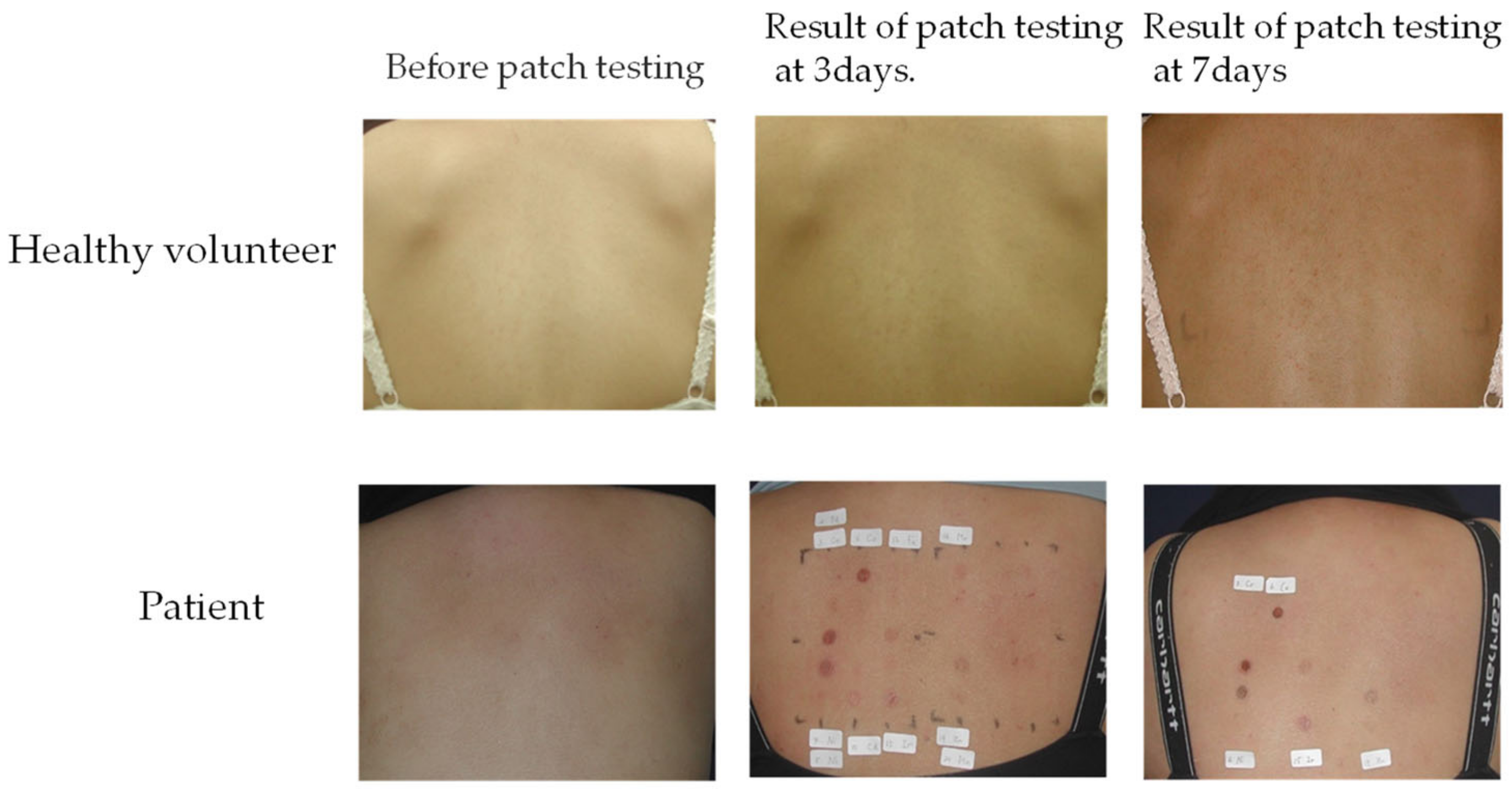
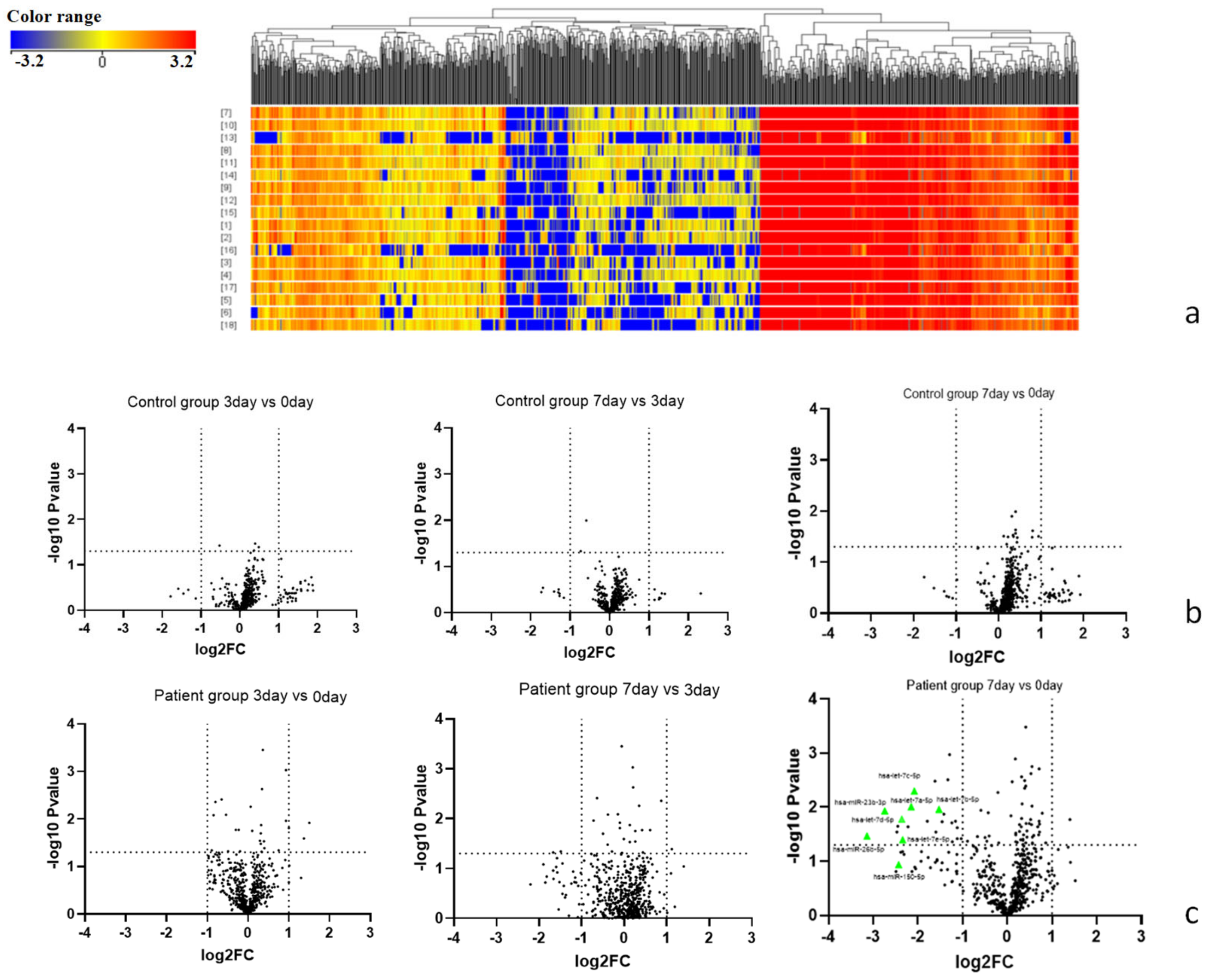
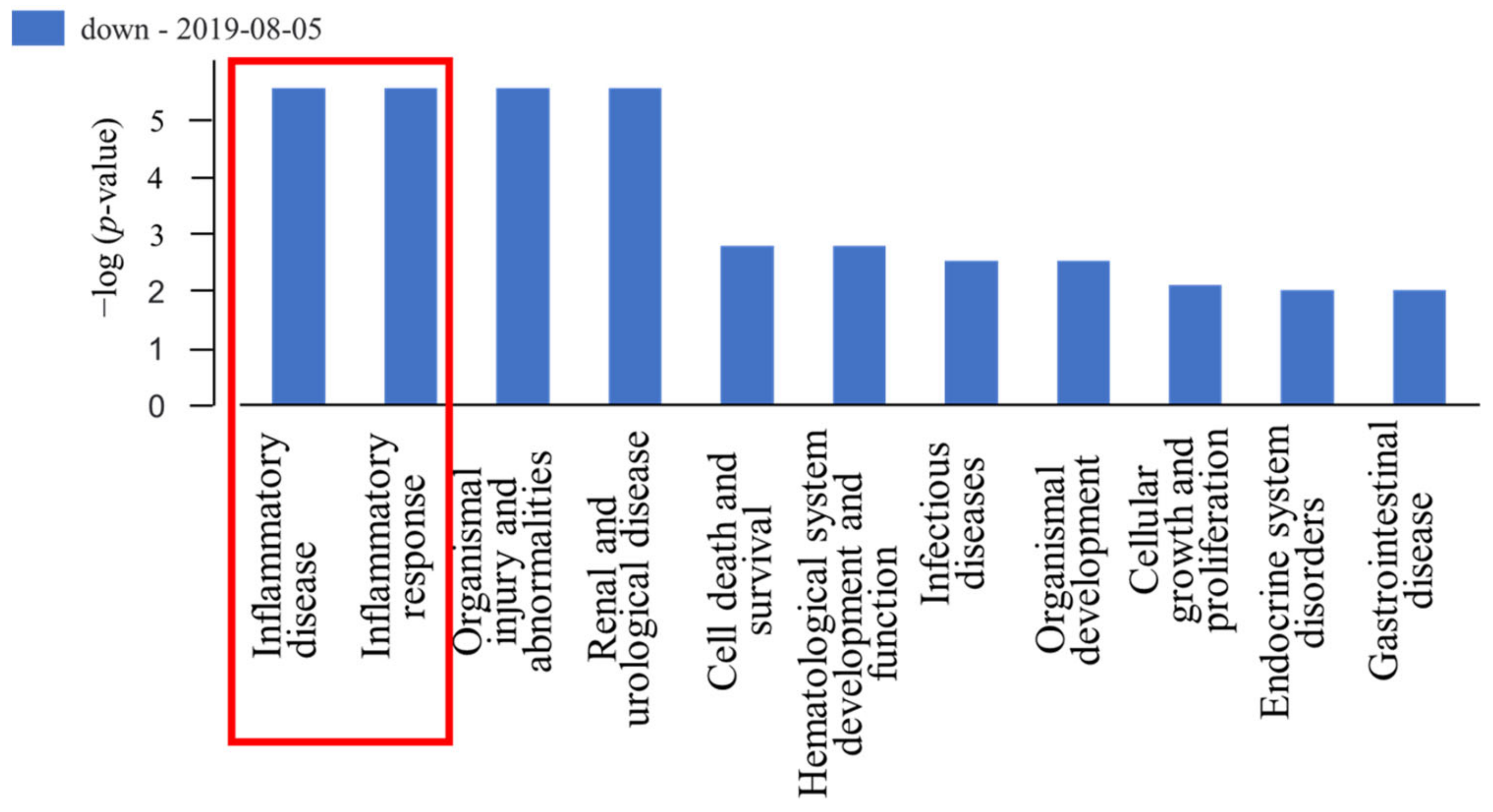
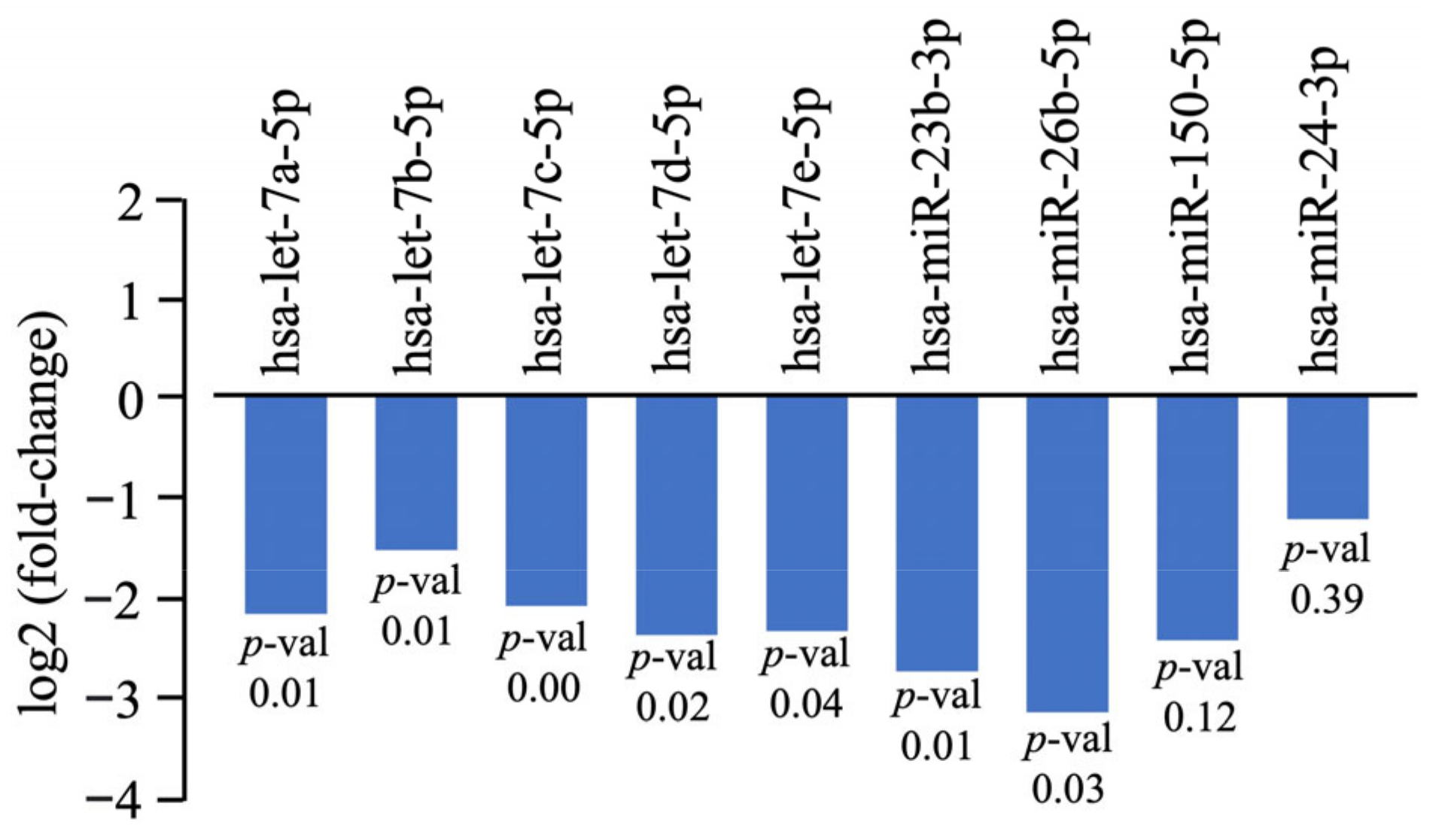
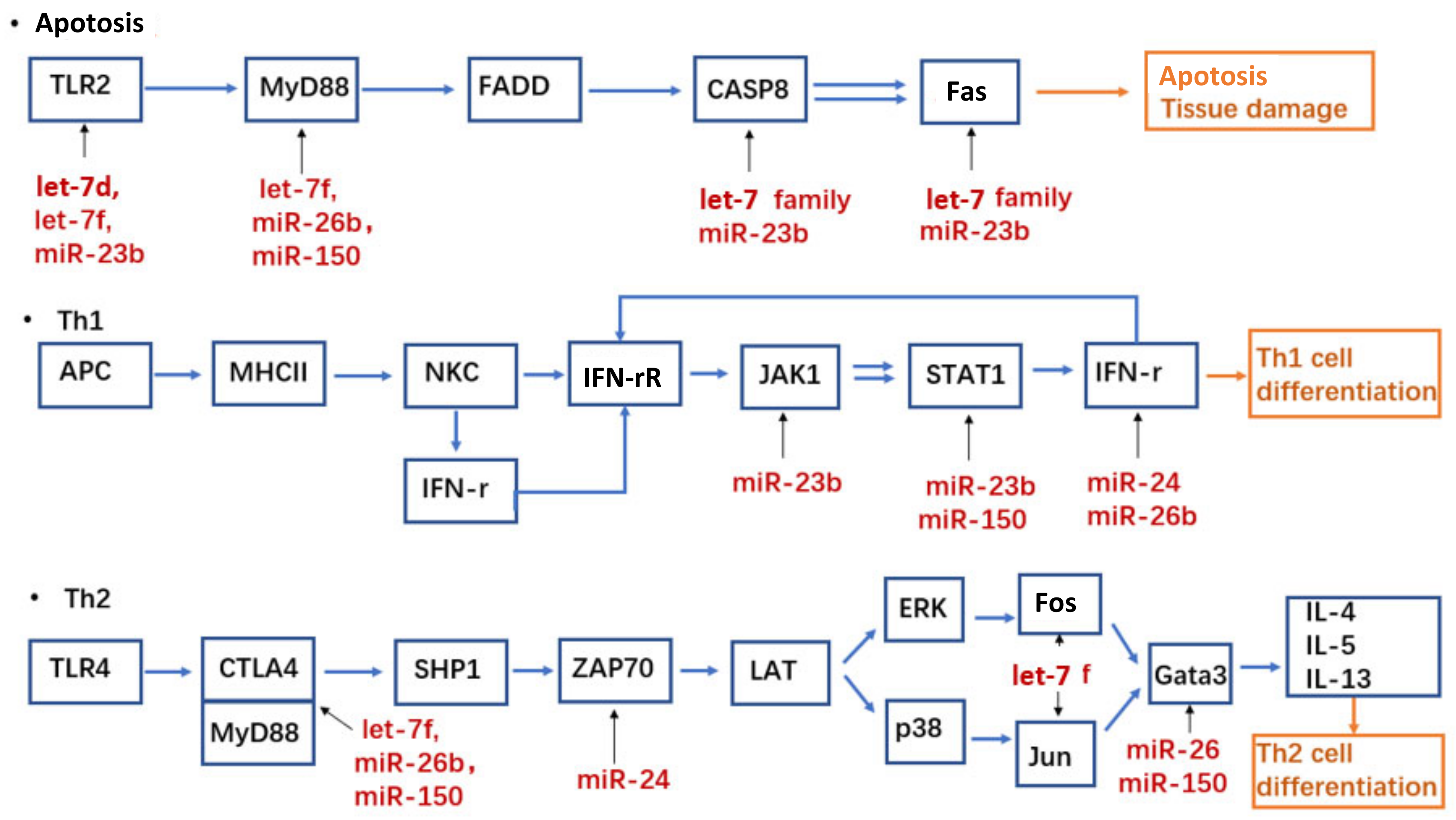
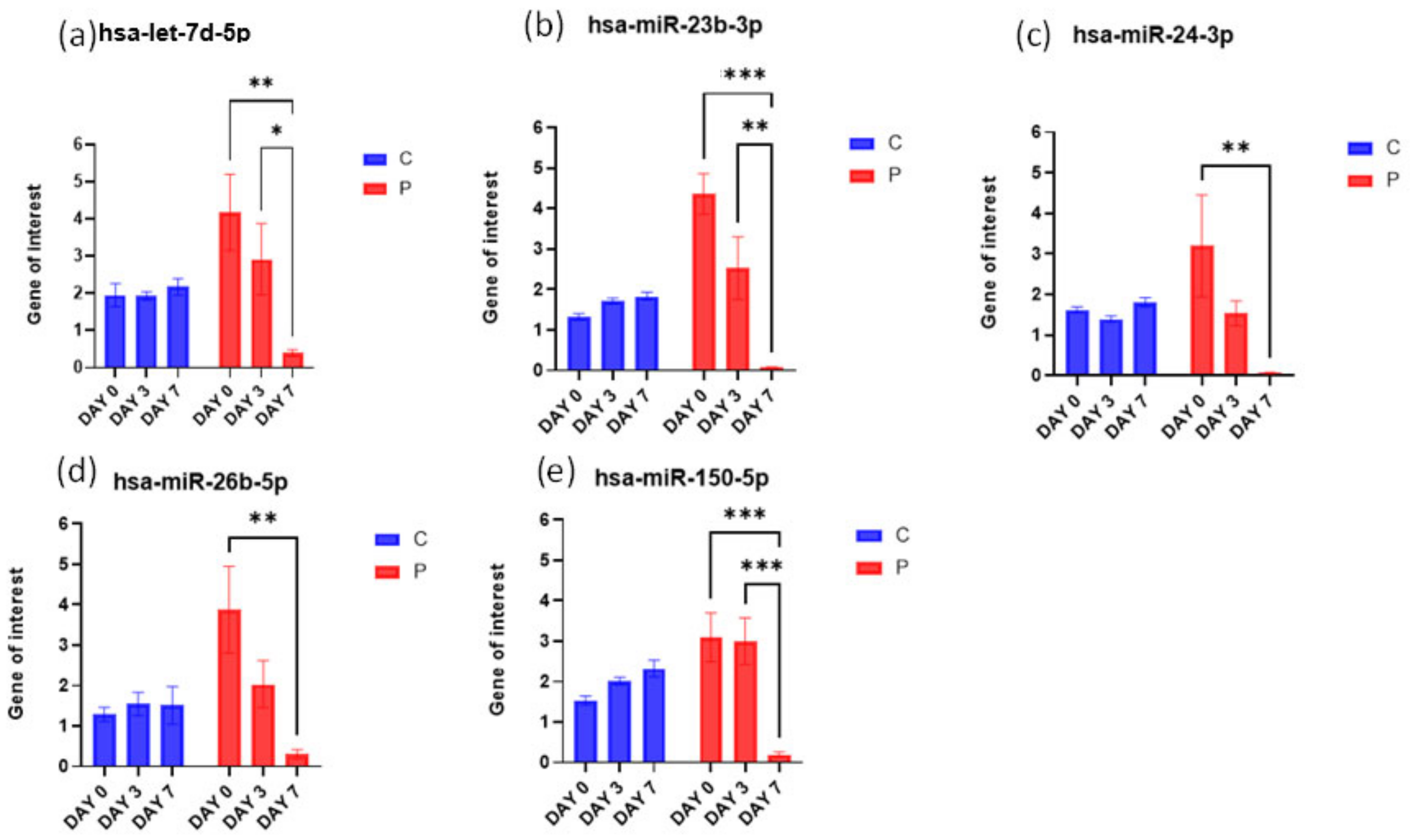
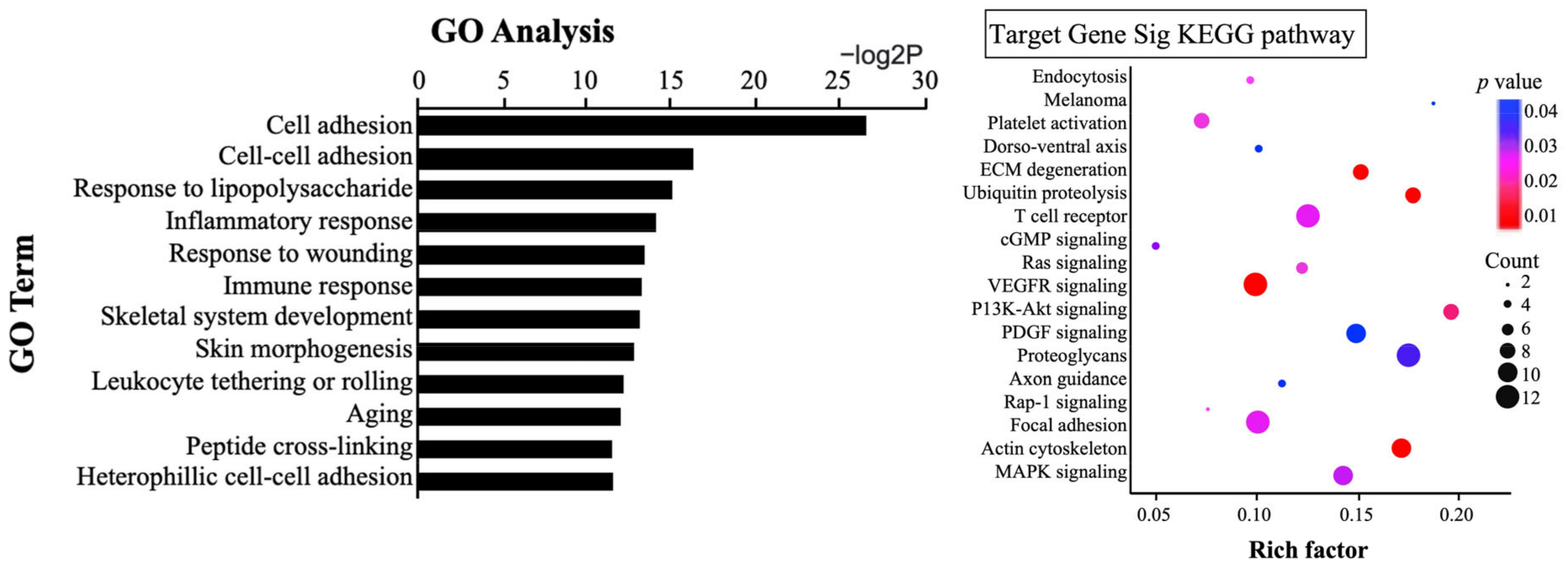
| Subjects | Gender | Age | Race |
|---|---|---|---|
| C1 | F | 22 | Asian |
| C2 | F | 26 | Asian |
| C3 | F | 28 | Asian |
| P1 | F | 23 | Asian |
| P2 | F | 23 | Asian |
| P3 | F | 24 | Asian |
| No | Allergen | % | Vehicle | P1 | P2 | P3 | C1 | C2 | C3 |
|---|---|---|---|---|---|---|---|---|---|
| 1 | CuSO4 | 2 | Aq | - | - | - | - | - | - |
| 2 | PdCl2 | 1 | Aq | - | + | ++ | - | - | - |
| 3 | K2Cr2O7 | 0.5 | Aq | ++ | - | - | - | - | - |
| 4 | NiSO4 | 5 | Aq | ++ | ++ | +++ | - | - | - |
| * 5 | NiSO4 | 2 | Aq | ?+ | ++ | +++ | - | - | - |
| 6 | CoCl2 | 2 | Aq | ++ | + | ++ | - | - | - |
| * 7 | HgCl2 | 0.1 | Aq | - | ?+ | - | - | - | - |
| 8 | HgCl2 | 0.05 | Aq | - | - | - | - | - | - |
| 9 | SnCl4 | 1 | Aq | - | - | ?+ | - | - | - |
| * 10 | CdSO4 | 1 | Aq | - | + | - | - | - | - |
| 11 | HAuCl4 | 0.2 | Aq | - | - | ?+ | - | - | - |
| 12 | H2PtCl6 | 0.5 | Aq | - | - | - | - | - | - |
| 13 | FeCl3 | 2 | Aq | - | - | - | - | - | - |
| 14 | InCl3 | 1 | Aq | - | - | - | - | - | - |
| 15 | IrCl4 | 1 | Aq | ++ | - | - | - | - | - |
| * 16 | MoCl5 | 1 | Aq | - | - | - | - | - | - |
| 17 | AgBr | 2 | Pet | - | - | - | - | - | - |
| 18 | SbCl3 | 1 | Pet | - | + | - | - | - | - |
| 19 | ZnCl2 | 2 | Pet | + | - | - | - | - | - |
| 20 | MnCl2 | 2 | Pet | - | - | - | - | - | - |
| 21 | CrSO4 | 2 | Aq | - | - | - | - | - | - |
| 22 | Al2O3 | 2 | Aq | - | - | - | - | - | - |
| ** 23 | TiO2 | 0.1 | Pet | - | - | - | - | - | - |
| ** 24 | Ti | 1 | Pet | - | - | - | - | - | - |
| * 25 | BaCl2 | 0.5 | Aq | - | - | - | - | - | - |
| * 26 | BaCl2 | 0.1 | Aq | - | - | - | - | - | - |
| * 27 | TiCl4 | 0.1 | Aq | - | - | - | - | - | - |
| * 28 | TiCl4 | 0.05 | Aq | - | - | - | - | - | - |
| miRNA ID | 3D-Gene v.16 Microarray Id | Accession * | miRNA Mature Sequence | Primer Sequence |
|---|---|---|---|---|
| hsa-let-7d-5p | hsa-let-7d | MI0000065 | CCUAGGAAGAGGUAGUAGGU | AGAGGUAGUAGGUUGCAUAGUU |
| hsa-miR-23b-3p | hsa-mir-23b | MI0000439 | CUCAGGUGCUCUGGCUGCUU | AUCACAUUGCCAGGGAUUACCAC |
| hsa-miR-26b-5p | hsa-mir-26b | MI0000084 | CCGGGACCCAGUUCAAGUAA | UUCAAGUAAUUCAGGAUAGGU |
| hsa-miR-150-5p | hsa-mir-150 | MI0000479 | CUCCCCAUGGCCCUGUCUCCC | UCUCCCAACCCUUGUACCAGUG |
| hsa-miR-24-3p | hsa-miR-24-3p | MIMAT0000080 | UGGCUCAGUUCAGCAGGAACAG | TGGCTCAGTTCAGCAGGAAC |
Disclaimer/Publisher’s Note: The statements, opinions and data contained in all publications are solely those of the individual author(s) and contributor(s) and not of MDPI and/or the editor(s). MDPI and/or the editor(s) disclaim responsibility for any injury to people or property resulting from any ideas, methods, instructions or products referred to in the content. |
© 2023 by the authors. Licensee MDPI, Basel, Switzerland. This article is an open access article distributed under the terms and conditions of the Creative Commons Attribution (CC BY) license (https://creativecommons.org/licenses/by/4.0/).
Share and Cite
Zhang, Y.; Hosoki, M.; Oshima, M.; Tajima, T.; Miyagi, M.; Raman, S.; Raju, R.; Matsuka, Y. Identification of microRNA Signatures in Peripheral Blood of Young Women as Potential Biomarkers for Metal Allergy. Biomedicines 2023, 11, 277. https://doi.org/10.3390/biomedicines11020277
Zhang Y, Hosoki M, Oshima M, Tajima T, Miyagi M, Raman S, Raju R, Matsuka Y. Identification of microRNA Signatures in Peripheral Blood of Young Women as Potential Biomarkers for Metal Allergy. Biomedicines. 2023; 11(2):277. https://doi.org/10.3390/biomedicines11020277
Chicago/Turabian StyleZhang, Yuehui, Maki Hosoki, Masamitsu Oshima, Toyoko Tajima, Mayu Miyagi, Swarnalakshmi Raman, Resmi Raju, and Yoshizo Matsuka. 2023. "Identification of microRNA Signatures in Peripheral Blood of Young Women as Potential Biomarkers for Metal Allergy" Biomedicines 11, no. 2: 277. https://doi.org/10.3390/biomedicines11020277
APA StyleZhang, Y., Hosoki, M., Oshima, M., Tajima, T., Miyagi, M., Raman, S., Raju, R., & Matsuka, Y. (2023). Identification of microRNA Signatures in Peripheral Blood of Young Women as Potential Biomarkers for Metal Allergy. Biomedicines, 11(2), 277. https://doi.org/10.3390/biomedicines11020277






